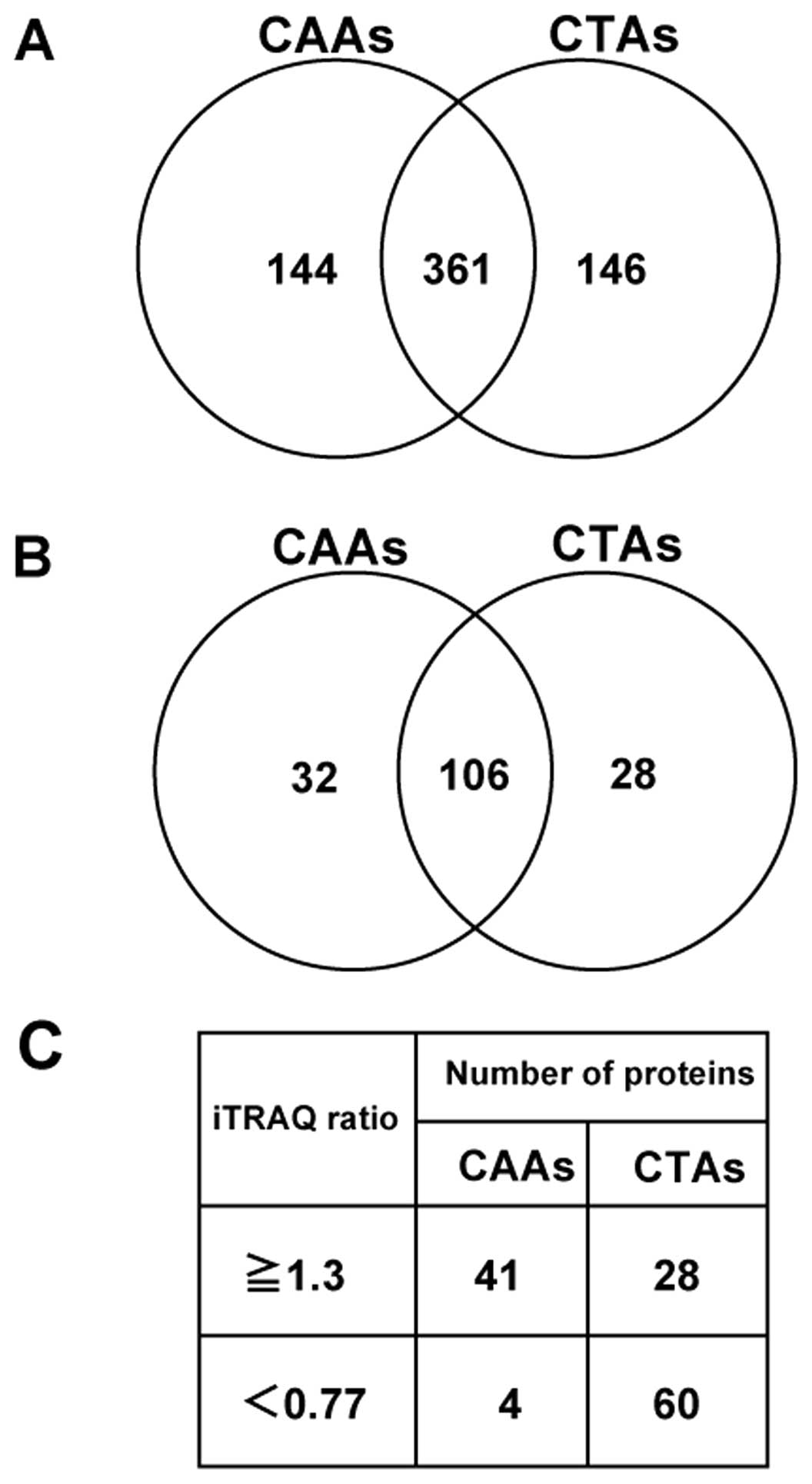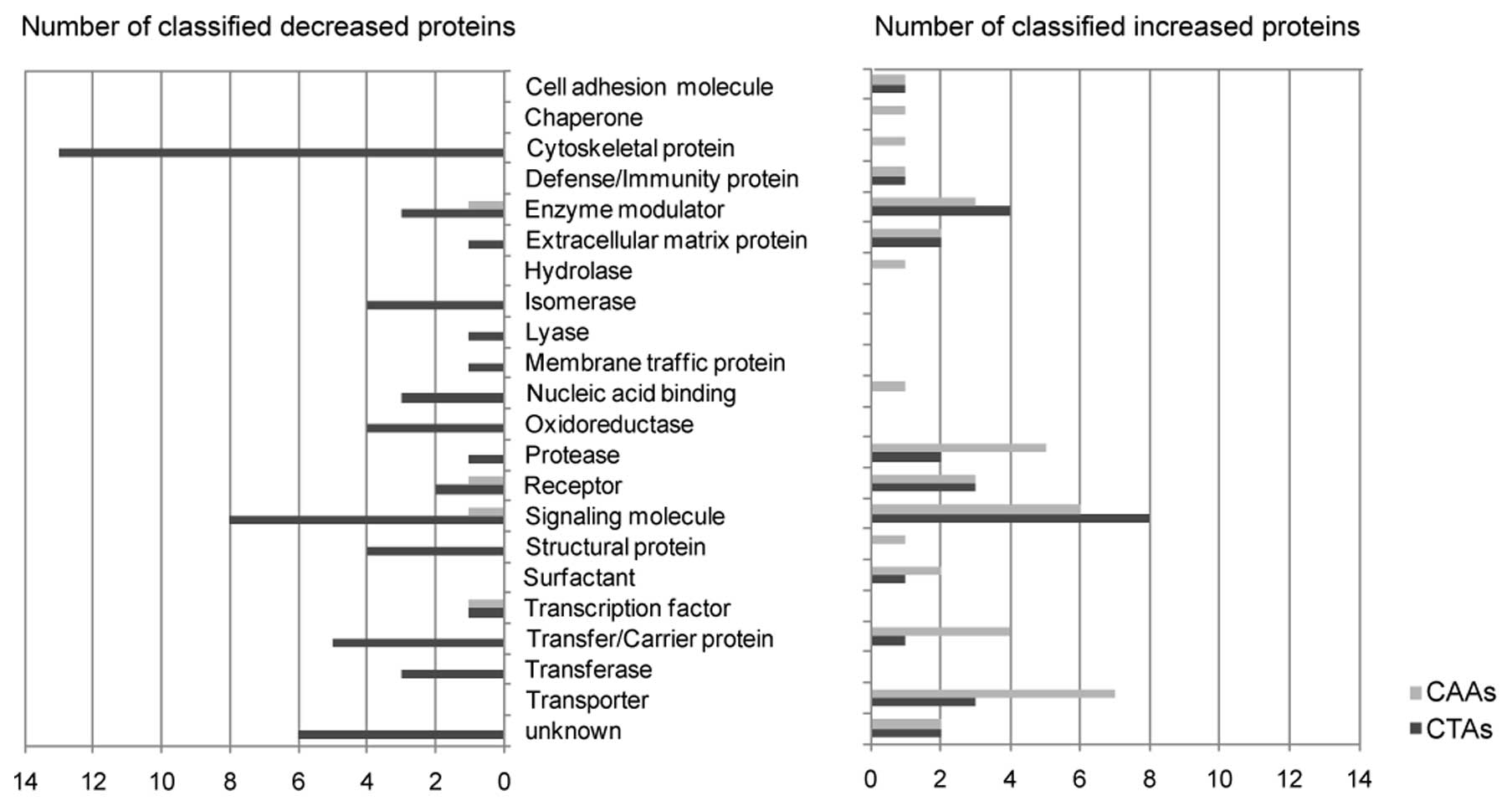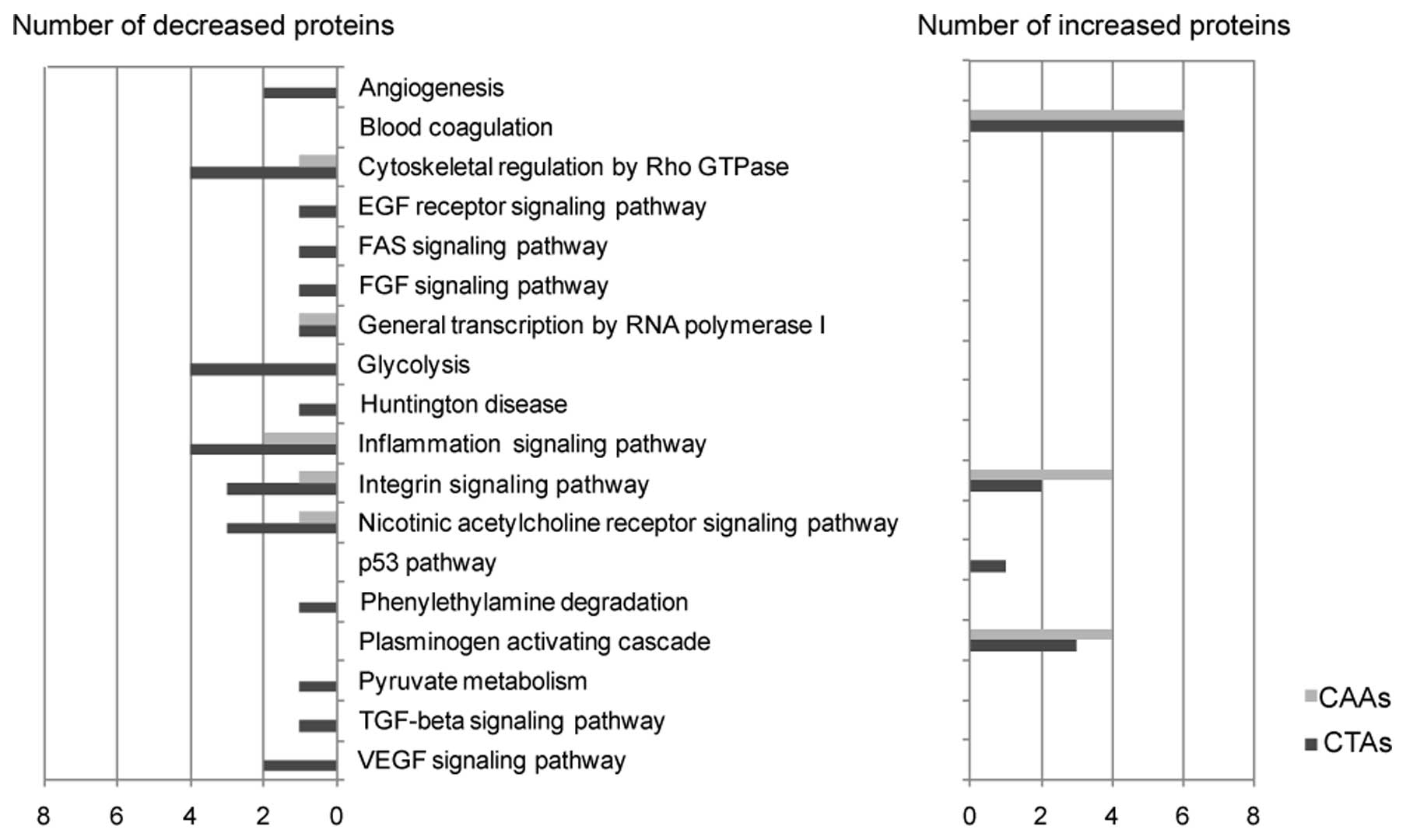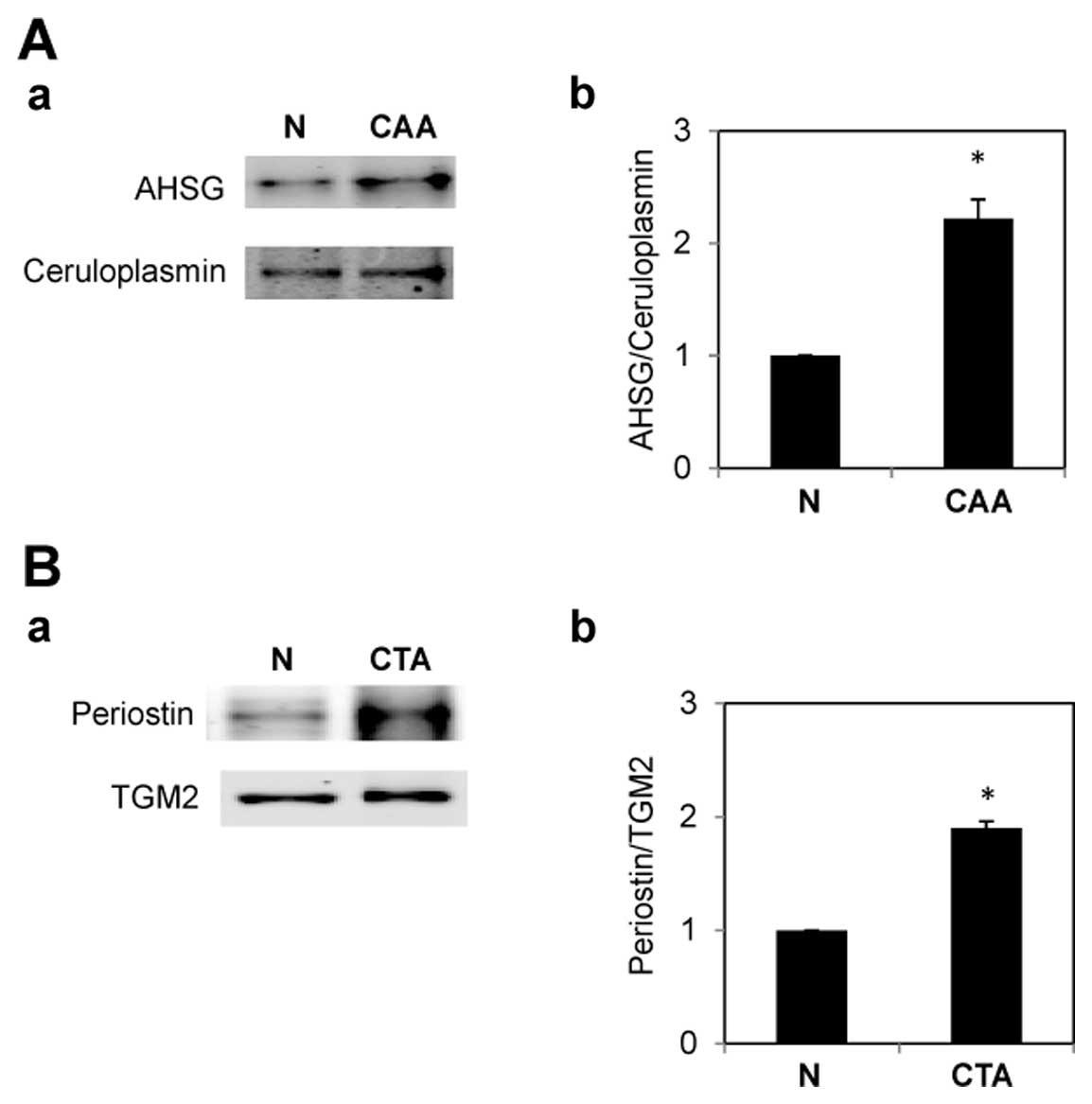Introduction
Aortic aneurysm is a severe cardiovascular disease
with high mortality and morbidity rates. It is associated with
advanced age, male gender, cigarette smoking, atherosclerosis,
hyper-tension, family history, and genetic predisposition (1). Aortic aneurysms most frequently
arise in the infrarenal abdominal aorta [so-called abdominal aortic
aneurysm (AAA)] and the descending or ascending portion of the
thoracic aorta [so-called thoracic aortic aneurysm (TAA)].
Previous studies have provided evidence for
involvement of proteolysis and the immune system in aortic aneurysm
formation and progression at the molecular level (2,3).
Histologically, fragmentation and degeneration of elastin and
collagen are generally observed in the media in the aneurysm wall.
Numerous molecular mediators and extracellular matrix-degrading
proteinases participate in the progression of AAAs. Matrix
metalloproteinases (MMPs) and their antagonists, tissue inhibitors
of metalloproteinases (TIMPs), are instrumental in aneurysm
formation and progression. Members of the gelatinase subclass,
MMP-2 and MMP-9, have been studied with regard to aneurysm
formation (2). Growth and rupture
of AAAs result from increased collagen turnover by increased type I
collagen degradation within AAAs (4). Other causes of aortic wall weakening
are apoptosis of vascular smooth muscle cells (VSMCs) and
transmural infiltration of lymphocytes and macrophages within AAA
aortas providing the stimulation for a chronic inflammatory
response (5). An association of
atherosclerotic lesions with the formation of AAAs in the intima of
the aorta has also been proposed, although it is still
controversial. Supporting evidence for the association of AAAs with
atherosclerosis includes similar aortic regions being prone to both
diseases (6). On the other hand,
there are several lines of evidence suggesting that atherosclerosis
is not a prerequisite for AAA formation (7).
The prevalence of TAAs is only about one-third of
that of AAAs (3). Structural
heterogeneity of the aorta has been shown between the thoracic and
abdominal aortic regions (8). The
structural heterogeneity of thoracic and abdominal aortas may
contribute to the differences observed in the pathogenesis of AAAs
and TAAs. The thoracic aorta has a thinner intima, thicker media,
and more medial lamellar units than those of the abdominal aorta.
In addition, the thoracic aorta has significantly higher elastin
and collagen contents and a lower collagen-toelastin ratio than
those of the abdominal aorta. In contrast to the abdominal region,
atherosclerosis rarely presents in the thoracic region. Medial
degeneration is qualitatively and quantitatively much greater in
patients with TAAs than in patients with AAAs. Lesauskaite et
al (9) demonstrated that
MMP-2 and MMP-9 activities were increased at portions of medial
degeneration in aortas from patients with TAAs. Furthermore, ∼20%
of TAAs are attributed to some genetic syndromes (10).
In many cases, aortic aneurysms are accompanied by
vascular calcification. Calcified arteries lose their elasticity,
resulting in exacerbation of ischemia, and increase in cardiac
afterload. Vascular calcification occurs at two histological sites
of arteries, the intima and the media. Intimal calcification is
associated with late-stage atherosclerosis with a passive
deposition of hydroxyapatite (calcium phosphate) into necrotic and
apoptotic lesions of the plaques (11). In areas with tissue degeneration
in the vascular wall, hydroxyapatite precipitation occurs when the
physiological calcium phosphate concentration exceeds the threshold
of solubility (12). On the other
hand, medial calcification, such as that in Mönckeberg’s medial
sclerosis results from active processes with some similarities to
osteogenesis (13). The vascular
calcification process has been proposed (14). Inflammation triggered by elastin
degradation, lipid deposition or pathogens in the vascular wall
induces activation and proliferation. Activated macrophages induce
proliferation and differentiation of neighboring VSMCs or stem
cells with mesenchymal differentiation potential into osteogenic
precursor cells. Through secreted molecules and direct cell-cell
interaction, the osteogenic precursor cells differentiate to
osteoblast-like cells. These osteoblast-like cells deposit bone
matrix proteins that are subsequently mineralized. At that time,
matrix vesicles and apoptotic bodies from VSMCs functioning as the
nidus for mineral nucleation facilitate vascular calcification. In
the process, the gain of calcification promoters, such as bone
morphogenetic proteins (BMPs) and the loss of calcification
inhibitors, such as matrix Gla protein (MGP) and fetuin-A (also
known as α2-Heremans-Schmid glycoprotein or α-2-HS glycoprotein)
are involved. The factors governing bone formation overlap with
those of vascular calcification (15).
The development of proteomic analyses and cDNA
microarray techniques has made it possible to examine comprehensive
differential expression of numerous proteins or genes between two
conditions. Recently, proteomic analyses have been applied to
clarify molecular alterations in AAAs (16). cDNA microarray analysis has also
been applied to diverse disease processes including AAAs (17) and TAAs (18). However, the spectrum of molecular
alterations that may occur in calcified aneurysms remains
unknown.
The purpose of this study was to establish proteomic
profiles of differentially expressed proteins in calcified
abdominal aortic aneurysms (CAAs) and calcified thoracic aortic
aneurysms (CTAs) relative to adjacent normal aorta tissues.
Recently, a variety of large-scale mass spectrometry (MS)-based
analyses with high sensitivity for detection and quantification of
differentially expressed proteins between two conditions have been
developed. In order to uncover proteins that are significantly
changed in CAAs and CTAs, the isobaric tag for absolute and
relative quantitation (iTRAQ) technology (19) coupled with nano liquid
chromatography (nanoLC)-matrix-assisted laser desorption ionization
(MALDI)-time of flight (TOF/TOF)-tandem MS (MS/MS) followed by
ProteinPilot analysis (20) was
used in this study as a quantitative proteomic approach. We
performed a detailed characterization of CAAs and CTAs and revealed
differences between normal aorta tissues and CAAs or CTAs.
Materials and methods
Patients and samples
The participants gave informed consent, and the
studies were performed with the approval of the Ethics Committee of
Shimane University School of Medicine, Japan. Calcified aortic
aneurysm tissues were obtained at surgery from subjects with CAAs
(n=6) and from subjects with CTAs (n=6) who underwent elective
aneurysm repair. Reference samples were obtained from normal aorta
tissues adjacent to CAA or CTA tissues. Tissue samples were
snap-frozen in liquid nitrogen and stored at −80°C until protein
extraction.
Sample preparation
Sample preparation was performed according to the
manual supplied by AB Sciex (Foster, CA, USA). Briefly, ∼20 mg of
the CAA or CTA samples and neighboring normal aorta tissues as
controls were subjected to protein extraction. After adding urea
lysis buffer containing 7 M urea, 0.1% Nonidet P-40 (NP-40) and 500
mM triethyl-ammonium bicarbonate (TEAB) (Sigma, Tokyo, Japan), the
sample was sonicated 5 times for 10 sec each time on ice using a
Sonifier 450 sonicating probe (Branson Japan, Atsugi, Japan),
incubated at 4°C for 1 h with constant shaking, and centrifuged at
10,000 × g for 10 min, and then the supernatant was collected. The
supernatant was desalted and its buffer was exchanged with 50 mM
TEAB using spin concentrators (Corning, Tokyo, Japan). The protein
concentration was determined using a bicinchoninic acid (BCA) assay
(Pierce, Rockford, IL, USA).
Denaturation, reduction, trypsin
digestion, and iTRAQ labeling
Labeling with iTRAQ was performed using iTRAQ™
Reagent from AB Sciex as described in the manufacturer’s
instructions. Briefly, as described previously (20), each of 50 μg of CAA or CTA samples
and neighboring normal aorta samples was denatured by sodium
dodecyl sulfate (SDS) and reduced by
[tris-(2-carboxyethyl)phosphine (TCEP)] as described previously.
Then cysteine alkylation was performed using
methylmethanethiosulfonate (MMTS). Subsequently, each sample was
cleaved by trypsin. Digests were labeled with an iTRAQ Reagent
Multiplex kit (AB Sciex). iTRAQ label 114 or 115 was used for
labeling the control sample, and iTRAQ label 116 or 117 was used
for labeling the CAA or CTA sample. Then the labeled control and
the calcified aneurysmal samples were combined.
Strong cation exchange (SCX)
chromatograpy and nanoLC
SCX chromatography was performed with the AB Sciex
cation exchange system according to the manufacturer’s
instructions. Subsequently, 6 fractions were collected and desalted
by a Sep-Pac C18 cartridge according to the instructions
of Waters Corporation (Milford, MA, USA). Fractionation with a
NanoLC system was performed according to the instructions of the
manufacturer (KYA Technologies, Tokyo, Japan). A total of 171
fractions per one fraction of SCX chromatography were collected
onto an Opti-TOF LC/MALDI 384 target plate (AB Sciex) using a DiNa
Map fraction collector (KYA Technologies). The methods for this
step have been described in detail in our previous paper (20).
MS analysis and protein identification
and relative quantification
The Mass Spectrometer 5800 MALDI-TOF/TOF Analyzer
(AB Sciex) with TOF/TOF Series software (version 4.0) was used for
MS data acquisition in a positive ion mode. Monoisotopic precursor
selection for MS/MS was performed by automatic precursor selection
with an interpretation method using the DynamicExit Algorithm (AB
Sciex). The peptide data obtained by 5800 MALDI TOF/TOF MS/MS were
analyzed with ProteinPilot™ 3.0 software using the Paragon protein
database search algorithm (AB Sciex) (21). Each MS/MS spectrum was searched
against the database constructed by AB Sciex (version 20081216;
20,489 entries).
Bioinformatic analysis
The Panther system (version 7) (http://www.pantherdb.org/) was used for classification
and pathway analyses of proteins. The annotations of proteins were
obtained from the Uniprot database (http://www.uniprot.org/) and appropriate literature.
Clustering analysis of differentially expressed proteins was
performed by the Genesis software provided by the Genesis team of
Institute for Genomics and Bioinformatics, Graz University of
Technology (Graz, Austria) (http://genome.tugraz.at/) (22).
Western blot analysis
Twenty micrograms of cell lysates extracted with
urea lysis buffer as described above was electrophoresed through
10% SDS-polyacrylamide gel (PAGE), and proteins were subsequently
electroblotted onto Hybond ECL nitrocellulose membranes (GE
Healthcare Japan, Hino, Japan). The membranes were blocked at room
temperature for 1 h with 5% nonfat dry milk in TBST [20 mM Tris-HCl
(pH 7.5), 150 mM NaCl, 0.1% Tween-20] and then incubated with
rabbit polyclonal anti-α-2-HS-glycoprotein antibody (0.5 μg/ml in
TBST with 1% milk) (Calbiochem, Darmstadt, Germany), rabbit
polyclonal anti-ceruloplasmin antibody (Epitomics, Burlingame, CA,
USA), mouse monoclonal anti-periostin antibody (Sigma-Aldrich, St.
Louis, MO, USA), or rabbit polyclonal anti-TGM2 antibody
(Epitomics) for 1 h at room temperature. Membranes were washed
three times with TBST and incubated with anti-rabbit or anti-mouse
Alexa Fluor 680-conjugated or IRDye 800-conjugated immunoglobulin
(Ig)G, followed by visualization using the infrared imaging system
Odyssey (LI-COR, Inc., Lincoln, NE, USA). Data from duplicate
experiments were analyzed for statistical significance by the
unpaired t-test. Statistical significance was set at the 95% level
(P<0.05).
Results
Quantitative analysis of differentially
expressed proteins between CAA or CTA and adjacent normal aorta
tissues
A total of 6 calcified abdominal aortic aneurysmal
tissues and adjacent normal aorta tissues were collected from 6 CAA
patients. Similarly, 6 calcified thoracic aortic aneurysmal tissues
and adjacent normal aorta tissues were collected from 6 CTA
patients. Protein expression was compared between each calcified
aneurysmal tissue and adjacent normal artery using iTRAQ labeling
coupled to nanoLC-MALDI-TOF/TOF-MS/MS followed by ProteinPilot
analysis. A total of 505 differentially expressed proteins in 6 CAA
samples and 507 proteins in 6 CTA samples with 361 proteins in both
calcified aneurysmal tissues that were identified in more than one
sample were shown (Fig. 1A).
Among them, 138 differentially expressed proteins in 6 CAA samples
and 134 proteins in 6 CTA samples with 106 proteins in both
calcified aneurysmal tissues that were identified in at least 5
samples were shown using highly stringent criteria for protein
identification (unused ProtScore >2; confidence >99%)
(Fig. 1B). The relative
quantitation by ProteinPilot analysis was based on statistical
analysis. However, since most biochemical methods are apt to
include technical variation, we considered an additional cut-off
value at 1.3-fold change (≥1.3- or <0.77-fold) for iTRAQ ratios
to reduce false positive rates for the selection of differentially
expressed proteins. Finally, among them 41 and 28 proteins with
significantly increased expression (≥1.3-fold) and 4 and 60
proteins with significantly decreased expression (<0.77-fold)
were identified in CAAs and CTAs, respectively (Fig. 1C).
In les I–IV, increased and decreased proteins in
CAAs and CTAs compared with those in adjacent normal aorta tissues
are listed in the order of iTRAQ ratios. Among them, proteins such
as type I and type III collagens (16,23) in increased proteins in CAAs, type
I collagen, fibrinogen α, β, γ chains and prothrombin (24) in increased proteins in CTAs, and
fibulin-5 (DANCE) (25) in
decreased proteins in CTAs that are known to be involved in aortic
aneurysmal development and progression were identified. Proteins
such as matrix Gla protein, α-2-HS-glycoprotein (fetuin-A)
(15) and biglycan in increased
proteins in CAAs, mimecan (osteoglycin) in decreased proteins in
CAAs, α-2-HS-glycoprotein, and decorin and biglycan (26) in increased proteins in CTAs that
are known to participate in vascular calcification were also
identified.
Molecular function classification of
differentially expressed proteins
For the functional distribution, analysis of the
identified proteins with significant differential expression (≥1.3-
or <0.77-fold) in CAAs and CTAs was performed using the Panther
classification system, which sorts the proteins into respective
classes based on their biological process (Fig. 2). We classified the identified
variable proteins with increased expression in the following groups
with more than 4 proteins: transporter [7 proteins (17.1%)],
signaling molecule [6 proteins (14.6%)], protease [5 proteins
(12.2%)] and transfer/carrier protein [4 proteins (9.8%)] among 41
proteins of CAAs, and signaling molecule [8 proteins (28.6%)] and
enzyme modulator [4 proteins (14.3%)] among 28 proteins of CTAs. On
the other hand, the groups with decreased expression were
cytoskeletal protein [13 proteins (21.7%)], signaling molecule [8
proteins (13.3%)], transfer/carrier protein [5 proteins (8.3%)],
isomerase [4 proteins (6.7%)], oxidoreductase [4 proteins (6.7%)],
and structural proteins [4 proteins (6.7%)] among 60 proteins of
CTAs. There were no classified groups for decreased proteins in
CAAs. The transporter group included apolipoprotein C-III
(apoC-III), band 3 anion transport protein, apolipoprotein E
(apoE), apolipoprotein A-I (apoA-I), serum amyloid A-4 protein,
apolipoprotein A-II (apoA-II), and apolipoprotein A-IV (apoA-IV)
with increased expression in CAAs. The signaling molecule group
included fibrinogen γ, β, α chains, periostin, thrombospondin-1,
complement C1q subcomponent subunit C, complement C3, and type I
collagen α-1 with increased expression in CTAs. The cytoskeletal
protein group included transgelin, myosin regulatory light
polypeptide 9, tropomyosin β chain, cysteine and glycine-rich
protein 1, calponin-1, caldesmon, lipoma-preferred partner, myosin
light polypeptide 6, talin-1, moesin, vinculin, PDZ and LIM domain
protein 7, and gelsolin with decreased expression in CTAs.
Pathway analysis of differentially
expressed proteins
The Panther software was also used for pathway
analyses of proteins that were shown to have significant
differential expression (≥1.3- or <0.77-fold) in our study. It
was notable that 6 proteins with increased expression in both CAAs
and CTAs correspond to proteins found in the blood coagulation
pathway illustrated in Fig. 3. In
addition, two pathways each consisting of 4 proteins with increased
expression in CAAs corresponded to proteins in the plasminogen
activating cascade and the integrin signaling pathway. On the other
hand, three pathways consisting of each of 4 proteins with
decreased expression in CTAs corresponded to proteins in the
cytoskeletal regulation by Rho GTPase pathway, the glycolysis
pathway, and the inflammation mediated by chemokine and cytokine
signaling pathway.
Hierarchical clustering analysis of
differentially expressed proteins in CAAs and CTAs
Cluster analysis with the Genesis software was
performed for our identified proteins to evaluate the relation
between differentially expressed proteins that were identified in
at least 5 samples among 6 CAA samples or 6 CTA samples and to
identify interesting protein expression clusters (Fig. 4A). We examined 138 differentially
expressed proteins in CAAs and the 134 differentially expressed
proteins in CTAs. Interestingly, in CAAs, three proteins with
increased expression (type I collagen α-1 and α-2, and type III
collagen α-1) included in the integrin signaling pathway (Fig. 3) were clustered (Fig. 4A, left panel). On the other hand,
in CTAs, three proteins with increased expression (fibrinogen α, β,
γ chains) included in the blood coagulation pathway (Fig. 3), three proteins with decrease
expression (myosin-10, -11 and type XIV collagen α-1) included in
the inflammation mediated by chemokine and cytokine signaling
pathway (Fig. 3), and three
proteins with decreased expression (pyruvate kinase isozymes M1/M2,
phosphoglycerate kinase 1, and glyceraldehyde-3-phosphate
dehydrogenase (GAPDH)) included in the glycolysis pathway (Fig. 3) were clustered (Fig. 4A, right panel).
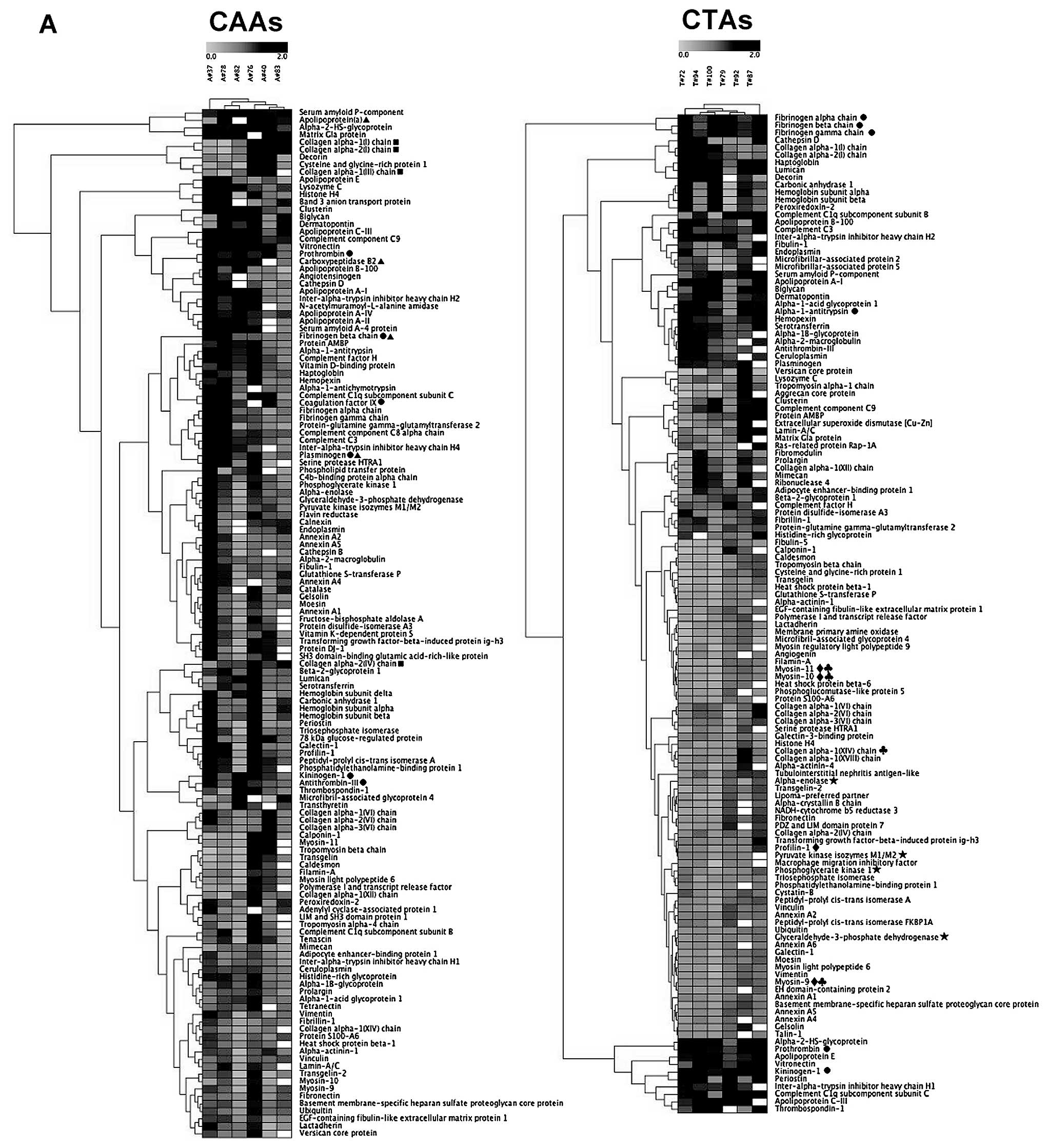 | Figure 4AHierarchical clustering analysis of
differentially expressed proteins in CAAs and CTAs by Genesis
software. (A) The dendrogram displays two-way hierarchical
clustering analyses of 138 differentially expressed proteins that
were commonly identified in at least 5 samples among 6 CAA samples
(A#37, A#40, A#76, A#78, A#82 and A#83) (left panel) and 134
differentially expressed proteins that were identified in at least
5 samples among 6 CTA samples (T#72, T#79, T#87, T#92, T#94 and
T#100) (right panel). Differences in iTRAQ ratios are color-coded.
Darker black spectra indicate increased expression, whereas lighter
grey spectra indicate decreased expression compared with those in
adjacent normal aorta tissues. White squares show no detection of
indicated proteins in corresponding samples. Type I collagen α-1
and α-2 chains, type III collagen α-1 chain and type IV collagen
α-2 chain included in the integrin signaling pathway with increased
expression in CAAs (Fig. 3) are
indicated with black squares in the left panel. Prothrombin,
fibrinogen β chain, coagulation factor IX, plasminogen, kininogen-1
and antithrombin-III included in the blood coagulation pathway with
increased expression in CAAs (Fig.
3) are indicated with black circles in the left panel.
Apolipoprotein(a), carboxypeptidase B2, fibrinogen β chain and
plasminogen included in the plasminogen activated cascade with
increased expression in CAAs (Fig.
3) are indicated with black triangles in the left panel.
Fibrinogen α, β and γ chains, α-1-antitrypsin, prothrombin and
kininogen-1 included in the blood coagulation pathway with
increased expression in CTAs (Fig.
3) are indicated with black circles in the right panel.
Myosin-11, myosin-10, profilin-1 and myosin-9 included in the
cytoskeletal regulation by Rho GTPase pathway with decreased
expression in CTAs (Fig. 3) are
indicated with black diamonds in the right panel. Myosin-11,
myosin-10, type XIV collagen α-1 and myosin-9 included in the
inflammation mediated by chemokine and cytokine signaling pathway
with decreased expression in CTAs (Fig. 3) are indicated with black
clover-shapes in the right panel. α-enolase, pyruvate kinase
isozymes M1/M2, glyceraldehyde-3-phosphate dehydrogenase and
phosphoglycerate kinase 1 included in the glycolysis pathway with
decreased expression in CTAs (Fig.
3) are indicated with black stars in the right panel. |
Subsequently, we performed cluster analysis of 12
calcified aortic aneurysmal samples from 6 CAA and 6 CTA patients
based on the expression patterns of differentially expressed
proteins of each sample (Fig.
4B). Samples of CAAs (patient nos. A#37, A#76, A#78 and A#82)
and samples of CTAs (T#72, T#79, T#87, T#92, T#94 and T#100) were
properly clustered. Interestingly, CAA samples from patients with
both CAAs and CTAs (A#40 and A#83) were clustered outside the
samples of patients with CAAs and were rather clustered with
samples of patients with CTAs.
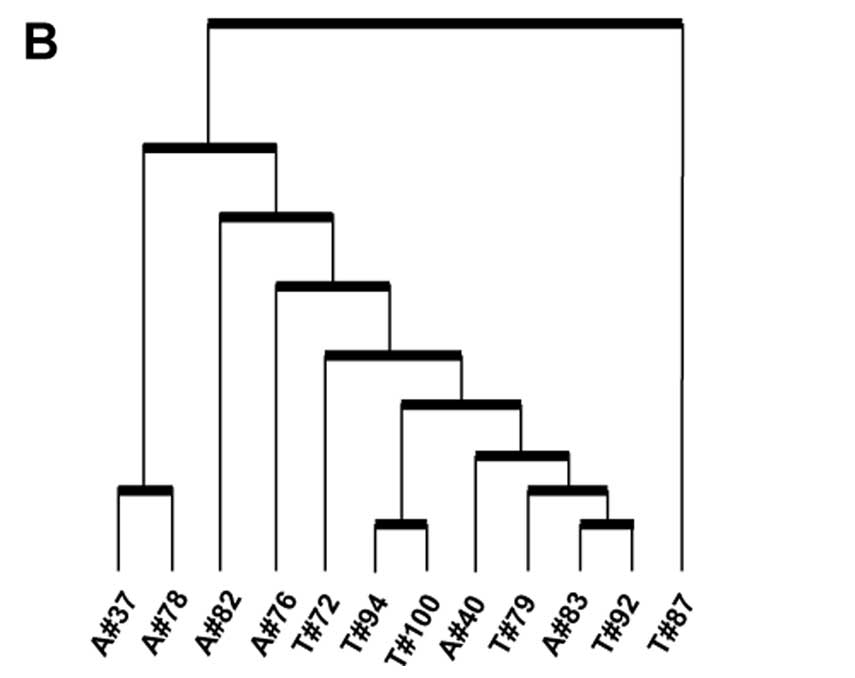 | Figure 4BHierarchical clustering analysis of
differentially expressed proteins in CAAs and CTAs by Genesis
software. (B) Hierarchical clustering of 12 calcified aortic
aneurysmal samples with 6 CAAs and 6 CTAs based on differentially
expressed proteins compared with those in adjacent normal aorta
tissues. One hundred forty differentially expressed proteins that
were commonly identified in at least 9 samples among 12 samples
(A#37, A#40, A#76, A#78, A#82, A#83, T#72, T#79, T#87, T#92, T#94
and T#100) were analyzed. |
Validation of iTRAQ ratio by western blot
analysis
To validate the accuracy of the quantitative results
by iTRAQ ratios of differentially expressed proteins, some proteins
with an iTRAQ quantitative ratio were quantified again by western
blot analysis. Ceruloplasmin (iTRAQ ratio, 1.00) in CAAs and
protein-glutamine γ-glutamyltransferase (referred to as TGM2)
(iTRAQ ratio, 0.99) in CTAs were used as proteins expressed
equivalently in a calcified aortic aneurysm and normal adjacent
blood vessel. On the other hand, α-2-HS-glycoprotein (referred to
as AHSG) (iTRAQ ratio, 2.21) in CAAs and periostin (iTRAQ ratio,
2.21) in CTAs were selected as representative proteins, since the
iTRAQ ratios of these proteins were relatively large. We performed
western blot analysis with anti-AHSG antibody and
anti-ceruloplasmin antibody against CAA and adjacent normal aortic
samples from patient A#40 (Fig.
5Aa). The ratio of increased expression of AHSG in the CAA
normalized with ceruloplasmin expression was determined by band
intensity and it was 2.22-fold (Fig.
5Ab). This value is consistent with the quantitative result
determined by the iTRAQ ratio (2.21). Similarly, western blot
analysis was performed with anti-periostin antibody and anti-TGM2
antibody against CTA and adjacent normal aortic samples from
patient T#94 (Fig. 5Ba). The
ratio of increased expression of periostin in the CTA normalized
with TGM2 expression was 1.90-fold (Fig. 5Bb). This value is nearly
consistent with the quantitative result determined by the iTRAQ
ratio (2.21). Overall, there was a good correlation between the
iTRAQ ratio and band intensity of western blot analysis.
Discussion
Calcified aortic aneurysm is a cardiovascular
disease. It is a complex disease with both genetic and various risk
factors, including aging, gender, and inflammation factors,
contributing to the development and progression of the disease. The
molecular pathogenesis of calcified aortic aneurysm is poorly
understood. In this study, we carried out a global proteomic study
on calcified aneurysmal tissues from abdominal and thoracic aortas
and adjacent normal aorta tissues. Quantitative proteomics using
iTRAQ labeling followed by nanoLC-MALDI-TOF/TOF-MS/MS analysis,
which is currently one of the most widely used approaches for
high-throughput protein quantitation, has been proven to be a
useful technique for examination of molecular mechanisms in
diseases. We used the iTRAQ proteomic approach to identify proteins
with differential expression between CAAs or CTAs and their
adjacent normal aorta tissues. As a result, 41 and 28 proteins with
increased expression (≥1.3-fold) and 4 and 60 proteins with
decreased expression (<0.77-fold) were shown to be proteins with
significant differential expression in CAAs and CTAs versus
adjacent normal aorta tissues, respectively.
Among the proteins with significant differential
expression in CAAs, type I collagen α-1 and type III collagen α-1
chains were increased, whereas type XIV collagen α-1 was decreased.
Collagen plays an important role in arterial wall integrity
(27). Appropriate amounts of
these collagens are essential for arterial integrity to endure the
forces exerted by blood pressure. Either increased or decreased
collagen in aortas may weaken the integrity of the aortic wall,
resulting in predisposition of aortic aneurysms. Interestingly,
increased amounts of collagens would lead to fibrosis, which may
result in arterial stiffness and increased susceptibility to
aneurysmal diseases. Similarly, not only collagens, but also other
extracellular matrix proteins such as fibulin-5 (also known as
DANCE) with regulated expression is essential for the functional
integrity of vessel walls. Fibulin-5 showed significantly decreased
expression in CTAs in this study. Fibulin-5 is essential for
elastogenesis with an elastogenic organizer activity (28).
Vascular calcification is frequently detected in
advanced atherosclerosis and aneurysms. Vascular calcification is a
highly regulated process with inducers and inhibitors responsible
for calcium deposition. An imbalance of these regulators results in
the initiation of calcification. Under normal conditions, inhibitor
proteins such as matrix Gla protein, BMP-7, α-2-HS glycoprotein
(fetuin-A), osteoprotegerin and osteopontin prevent vascular
calcification processes (29).
Among these representative inhibitors, matrix Gla protein and
α-2-HS glycoprotein were increased in CAAs and CTAs in this study.
These findings are consistent with previous observations by Spronk
et al (30). The
upregulation of these inhibitors in calcified aneurysms might be
explained by assuming a feedback mechanism of upregulated
production of these inhibitors, leading to the prevention of
further calcium phosphate deposition.
The abdominal and thoracic aortas share similarities
in their physical structures and cellular components. In this
study, 16 proteins including serum amyloid P-component, α-2-HS
glycoprotein, apolipoprotein C-III, prothrombin, and vitronectin
were significantly increased in both CAAs and CTAs (≥1.3-fold) and
3 proteins including type XIV collagen α-1 chain, myosin-10, and
polymerase I and transcript release factor were significantly
decreased in both CAAs and CTAs (<0.77-fold). These proteins
might provide the basis for the similar pathological phenotypes
between CAAs and CTAs. However, heterogeneity also exists between
abdominal and thoracic aortas. This difference contributes to
vessel mechanics, proteolytic activity, signaling pathways, and
atherosclerotic plaque deposition, leading to disparities in the
pathologic mechanisms involved in CAAs and CTAs. In the present
study, 3 proteins (histone H4, serine protease HTRA1, and cysteine
and glycine-rich protein 1) that were significantly increased in
CAAs but significantly decreased in CTAs were identified. On the
other hand, 10 proteins (including matrix Gla protein, clusterin,
lysozyme C, complement component C9, and cathepsin D) that were
significantly increased only in CAAs, one protein (mimecan) that
was significantly decreased only in CAAs, 12 proteins (including
fibrinogen γ and α chains, periostin, thrombospondin-1, and
haptoglobin) that were significantly increased only in CTAs, 35
proteins (including microfibril-associated glycoprotein 4,
α-actinin-1, transgelin, glutathione S-transferase P, and
heat-shock protein β-1) that were significantly decreased only in
CTAs were identified. These proteins with distinct expression
patterns might be involved in the different pathogenesis associated
with these two types of calcified aneurysms.
Although it is still controversial as to whether
atherosclerotic lesions are a prerequisite for the formation of
AAAs, it was found with the Panther classification system that
several kinds of apolipoproteins such as apoC-III, apoE, apoA-I,
apoA-II, and apoA-IV exhibited increased expression in CAAs
compared with their expression in control tissues in this study.
Apolipoproteins are deeply involved in lipid metabolism. The
development of atherosclerosis is associated with disorders of
lipoprotein metabolism (31).
Golledge et al (32)
demonstrated that a low high-density lipoprotein level is the most
sensitive predictor of AAA among lipid markers. However, several
lines of evidence have suggested potent anti-atherogenic roles of
apoE (33), apoA-I (34), apoA-II (35), and apoA-IV (36) in contrast to the atherogenic role
of apoC-III (37). In addition,
Sadek et al (38)
demonstrated the upregulation of ApoE mRNA synthesis in AAAs by
microarray analysis. The upregulation of apolipoproteins with
anti-atherogenic function in this study might be explained by
assuming a feedback mechanism of increased anti-atherogenic
apolipoproteins, possibly to prevent further atherosclerosis
required for calcified aortic aneurysms.
The presence of a chronic intraluminal thrombus
(ILT) is often found in aortic aneurysms. An ILT participates in
aneurysmal dilatation. An ILT is a highly biologically active site
in which fibrin formation following platelet and thrombin
activation occurs. The ILT is a laminated structure with several
layers of fibrin clots and an underlying hematic luminal layer with
undegraded crosslinked fibrin (39). Consistent with these observations,
the pathway analysis using Panther software in this study revealed
that 6 proteins with increased expression in both CAAs and CTAs are
involved in the blood coagulation pathway. Interestingly, Stec
et al (40) showed strong
linear relationships between plasma fibrinogen and cardiovascular
diseases.
Several studies have suggested that oxidative stress
is increased in aortic aneurysms and that modulation of reactive
oxygen species (ROS) influences the formation of aortic aneurysms
(41). In aortic aneurysms, ROS
are generated by many infiltrating leukocytes, and generation of
ROS leads to increased production of MMPs (42). Thus, it is important for
protection of aortic aneurysms to reduce the activity of
ROS-generating systems and/or to increase the levels of cellular
antioxidants and antioxidant enzymes, such as superoxide dismutase
(SOD) and glutathione S-transferase (GST). It has been reported
that SOD activity was reduced in AAA tissue samples (43). In addition, it is known that GST
is involved in the removal of products of potential atherogenic
substances, such as lipid oxides (44). In line with this evidence, it was
found in the present study that SOD (iTRAQ ratio, 0.77) and GST
(iTRAQ ratio, 0.54) were significantly decreased in CTAs compared
with those in normal tissues.
Increasing evidence suggests that oxidative stress
has effects on gene expression, protein stability, and enzymatic
activity. It has been reported that GAPDH is one of the targets for
oxidative stress. GAPDH plays an important role in energy
metabolism in the glycolytic pathway. Sukhanov et al
(45) showed that proatherogenic
molecule oxidized low-density lipoprotein (OxLDL) downregulates
GAPDH by decreasing protein stability, resulting in a reduction in
ATP levels. In the present study, it was found that GAPDH levels
decreased in CTAs compared with that in controls. Although we have
not shown whether oxidative stress is actually increased in aortic
aneurysms in the samples used in this study, it is possible that
the decreased level of GAPDH is due to the increase in oxidative
stress in CTAs. Furthermore, other decreased glycolytic enzymes
such as α-enolase, pyruvate kinase isozymes M1/M2, and
phosphoglycerate kinase 1 in the present study may also be targets
for oxidative stress.
Interestingly, as shown in Fig. 4B, it was found that the
expression patterns of differentially expressed proteins in CAAs
from patients with both CAAs and CTAs (A#40 and A#83) show more
resemblance to those in CTAs from patients with only CTAs than
those in CAAs from patients with only CAAs. We speculated that the
factors that influence the protein expression in CAAs may be
diffusely secreted from CTAs of patients A#40 and A#83 and, in
consequence, the protein expression patterns in CAAs from these
patients might be more closely related to those in CTAs than those
in CAAs.
In conclusion, this is the first comprehensive study
on the mechanisms of development and progression of calcified
abdominal aortic aneurysms (CAAs) and thoracic aortic aneurysms
(CTAs) using an iTRAQ proteomics approach. This study revealed many
novel proteins that had not been known to be associated with the
abdominal and thoracic aortic aneurysm formation and vascular
calcification.
Acknowledgements
We thank Yasuko Sonoyama for sample
collection. This study was supported in part by Grants-in-Aid for
Scientific Research from the Ministry of Education, Culture,
Sports, Science and Technology of Japan.
References
|
1.
|
S AnnambhotlaS BourgeoisX WangPH LinQ YaoC
ChenRecent advances in molecular mechanisms of abdominal aortic
aneurysm formationWorld J
Surg32976986200810.1007/s00268-007-9456-x18259804
|
|
2.
|
ZS GalisJJ KhatriMatrix metalloproteinases
in vascular remodeling and atherogenesis: the good, the bad, and
the uglyCirc Res90251262200211861412
|
|
3.
|
H KuivaniemiCD PlatsoucasMD Tilson
IIIAortic aneurysms: an immune disease with a strong genetic
componentCirculation117242252200810.1161/CIRCULATIONAHA.107.69098218195185
|
|
4.
|
H Abdul-HussienRG SoekhoeE WeberCollagen
degradation in the abdominal aneurysm: a conspiracy of matrix
metalloproteinase and cysteine collagenasesAm J
Pathol170809817200710.2353/ajpath.2007.06052217322367
|
|
5.
|
EL HendersonYJ GengGK SukhovaAD
WhittemoreJ KnoxP LibbyDeath of smooth muscle cells and expression
of mediators of apoptosis by T lymphocytes in human abdominal
aortic
aneurysmsCirculation9996104199910.1161/01.CIR.99.1.969884385
|
|
6.
|
J GolledgeJ MullerA DaughertyP
NormanAbdominal aortic aneurysm: pathogenesis and implications for
managementArterioscler Thromb Vasc
Biol2626052613200610.1161/01.ATV.0000245819.32762.cb16973970
|
|
7.
|
D ReedC ReedG StemmermannT HayashiAre
aortic aneurysms caused by
atherosclerosis?Circulation85205211199210.1161/01.CIR.85.1.2051728451
|
|
8.
|
JM RuddyJA JonesFG SpinaleJS
IkonomidisRegional heterogeneity within the aorta: relevance to
aneurysm diseaseJ Thorac Cardiovasc
Surg13611231130200810.1016/j.jtcvs.2008.06.02719026791
|
|
9.
|
V LesauskaiteP TanganelliC SassiSmooth
muscle cells of the media in the dilatative pathology of ascending
thoracic aorta: morphology, immunoreactivity for osteopontin,
matrix metalloproteinases, and their inhibitorsHum
Pathol3210031011200110.1053/hupa.2001.27107
|
|
10.
|
MA CoadyJA RizzoLJ GoldsteinJA
ElefteriadesNatural history, pathogenesis, and etiology of thoracic
aortic aneurysms and dissectionsCardiol
Clin17615635199910.1016/S0733-8651(05)70105-310589336
|
|
11.
|
JA RumbergerDB SimonsLA FitzpatrickPF
SheedyRS SchwartzCoronary artery calcium area by electron-beam
computed tomography and coronary atherosclerotic plaque area. A
histopathologic correlative
studyCirculation9221572162199510.1161/01.CIR.92.8.2157
|
|
12.
|
CM ShanahanMechanisms of vascular
calcification in renal diseaseClin
Nephrol63146157200510.5414/CNP6314615730057
|
|
13.
|
S LehtoL NiskanenM SuhonenT RönnemaaM
LaaksoMedial artery calcification. A neglected harbinger of
cardiovascular complications in non-insulin-dependent diabetes
mellitusArterioscler Thromb Vasc
Biol16978983199610.1161/01.ATV.16.8.978
|
|
14.
|
G RusanescuR WeisslederE AikawaNotch
signaling in cardiovascular disease and calcificationCurr Cardiol
Rev4148156200810.2174/15734030878516055219936191
|
|
15.
|
J KendrickM ChoncholThe role of phosphorus
in the development and progression of vascular calcificationAm J
Kidney Dis58826834201110.1053/j.ajkd.2011.07.02021956015
|
|
16.
|
A DidangelosX YinK MandalExtracellular
matrix composition and remodeling in human abdominal aortic
aneurysms: a proteomics approachMol Cell
Proteomics10M111.008128201110.1074/mcp.M111.00812821593211
|
|
17.
|
WS TungJK LeeRW ThompsonSimultaneous
analysis of 1176 gene products in normal human aorta and abdominal
aortic aneurysms using a membrane-based complementary DNA
expression arrayJ Vasc Surg34143150200110.1067/mva.2001.113310
|
|
18.
|
TS AbsiTM Sundt IIIWS TungAltered patterns
of gene expression distinguishing ascending aortic aneurysms from
abdominal aortic aneurysms: complementary DNA expression profiling
in the molecular characterization of aortic diseaseJ Thorac
Cardiovasc Surg126344357200310.1016/S0022-5223(02)73576-9
|
|
19.
|
PL RossYN HuangJN MarcheseMultiplexed
protein quantitation in Saccharomyces cerevisiae using
amine-reactive isobaric tagging reagentsMol Cell
Proteomics3115411692004
|
|
20.
|
K MatsumotoPhosphorylation of
extracellular matrix tenascin-X detected by differential mass
tagging followed by nanoLC-MALDI-TOF/TOF-MS/MS using ProteinPilot
softwareConnect Tissue
Res53106116201210.3109/03008207.2011.611600
|
|
21.
|
IV ShilovSL SeymourAA PatelThe Paragon
Algorithm, a next generation search engine that uses sequence
temperature values and feature probabilities to identify peptides
from tandem mass spectraMol Cell
Proteomics616381655200710.1074/mcp.T600050-MCP200
|
|
22.
|
A SturnJ QuackenbushZ TrajanoskiGenesis:
cluster analysis of microarray
dataBioinformatics18207208200210.1093/bioinformatics/18.1.20711836235
|
|
23.
|
X WangSA LeMaireL ChenIncreased collagen
deposition and elevated expression of connective tissue growth
factor in human thoracic aortic dissectionCirculation114Suppl
1I200I205200610.1161/CIRCULATIONAHA.105.000240
|
|
24.
|
Z TouatL LepageV
OllivierDilation-dependent activation of platelets and prothrombin
in human thoracic ascending aortic aneurysmArterioscler Thromb Vasc
Biol28940946200810.1161/ATVBAHA.107.158576
|
|
25.
|
X WangSA LeMaireL ChenDecreased expression
of fibulin-5 correlates with reduced elastin in thoracic aortic
dissectionSurgery138352359200510.1016/j.surg.2005.06.00616153447
|
|
26.
|
R WallinN WajihGT GreenwoodDC SaneArterial
calcification: a review of mechanisms, animal models, and the
prospects for therapyMed Res
Rev21274301200110.1002/med.101011410932
|
|
27.
|
LT JensenNB HøstCollagen: scaffold for
repair or executionCardiovasc
Res33535539199710.1016/S0008-6363(96)00247-79093523
|
|
28.
|
T NakamuraPR LozanoY IkedaFibulin-5/DANCE
is essential for elastogenesis in
vivoNature415171175200210.1038/415171a11805835
|
|
29.
|
R RezgFC BarretoDV BarretoS LiabeufTB
DrüekeZA MassyInhibitors of vascular calcification as potential
therapeutic targetsJ
Nephrol24416427201110.5301/JN.2011.842021688249
|
|
30.
|
HM SpronkBA SouteLJ SchurgersMatrix Gla
protein accumulates at the border of regions of calcification and
normal tissue in the media of the arterial vessel wallBiochem
Biophys Res Commun289485490200110.1006/bbrc.2001.599611716499
|
|
31.
|
RM KraussYA KesäniemiCardiovascular
disease and hyperlipidaemiaCurr Opin
Lipidol5249251199410.1097/00041433-199408000-000017981954
|
|
32.
|
J GolledgeF van BockxmeerK JamrozikM
McCannPE NormanAssociation between serum lipoproteins and abdominal
aortic aneurysmAm J
Cardiol105249251201010.1016/j.amjcard.2009.12.076
|
|
33.
|
K GreenowNJ PearceDP RamjiThe key role of
apolipoprotein E in atherosclerosisJ Mol
Med83329342200510.1007/s00109-004-0631-315827760
|
|
34.
|
G WalldiusI JungnerThe apoB/apoA-I ratio:
a strong, new risk factor for cardiovascular disease and a target
for lipid-lowering therapy-a review of the evidenceJ Intern
Med259493519200610.1111/j.1365-2796.2006.01643.x16629855
|
|
35.
|
A TailleuxP DuriezJC FruchartV
ClaveyApolipoprotein A-II, HDL metabolism and
atherosclerosisAtherosclerosis164113200210.1016/S0021-9150(01)00751-112119188
|
|
36.
|
S StanE DelvinM LambertE SeidmanE LevyApo
A-IV: an update on regulation and physiologic functionsBiochim
Biophys Acta1631177187200310.1016/S1388-1981(03)00004-012633684
|
|
37.
|
A KawakamiM YoshidaApolipoprotein CIII
links dyslipidemia with atherosclerosisJ Atheroscler
Thromb16611200910.5551/jat.E60719262004
|
|
38.
|
M SadekRL HynecekS GoldenbergKC KentML
MarinPL FariesGene expression analysis of a porcine native
abdominal aortic aneurysm
modelSurgery144252258200810.1016/j.surg.2008.04.00718656633
|
|
39.
|
JB MichelJL Martin-VenturaJ EgidoNovel
aspects of the pathogenesis of aneurysms of the abdominal aorta in
humansCardiovasc Res901827201110.1093/cvr/cvq33721037321
|
|
40.
|
JJ StecH SilbershatzGH ToflerAssociation
of fibrinogen with cardiovascular risk factors and cardiovascular
disease in the Framingham Offspring
PopulationCirculation10216341638200010.1161/01.CIR.102.14.163411015340
|
|
41.
|
ML McCormickD GavrilaNL WeintraubRole of
oxidative stress in the pathogenesis of abdominal aortic
aneurysmsArterioscler Thromb Vasc
Biol27461469200710.1161/01.ATV.0000257552.94483.1417218601
|
|
42.
|
K GroteI FlachM LuchtefeldMechanical
stretch enhances mRNA expression and proenzyme release of matrix
metalloproteinase-2 (MMP-2) via NAD(P)H oxidase-derived reactive
oxygen speciesCirc
Res92e80e86200310.1161/01.RES.0000077044.60138.7C
|
|
43.
|
MA DubickGC HunterS CaseyCL KeenAortic
ascorbic acid, trace elements, and superoxide dismutase activity in
human aneurysmal and occlusive diseaseProc Soc Exp Biol
Med184138143198710.3181/00379727-184-424573809168
|
|
44.
|
JW StephensBC BainSE
HumphriesGene-environment interaction and oxidative stress in
cardiovascular
diseaseAtherosclerosis200229238200810.1016/j.atherosclerosis.2008.04.00318490019
|
|
45.
|
S SukhanovY HigashiSY ShaiNovel effect of
oxidized low-density lipoprotein: cellular ATP depletion via
downregulation of glyceraldehyde-3-phosphate dehydrogenaseCirc
Res99191200200610.1161/01.RES.0000232319.02303.8c
|















